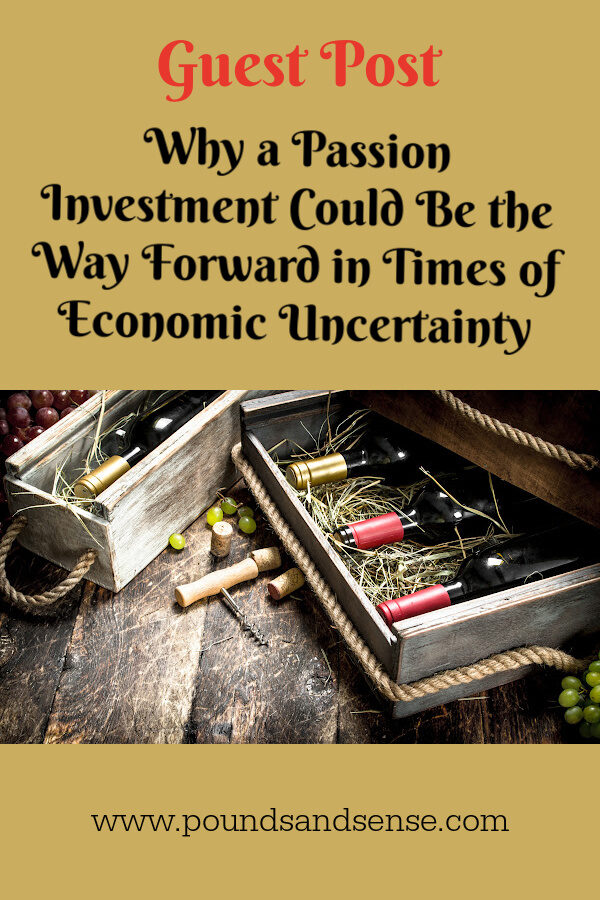Guest Post: Why a Passion Investment Could be the Way Forward in Times of Economic Uncertainty
Today I am pleased to bring you a guest post on a subject I freely admit I didn’t previously know much about.
Of course I was aware of Capital Gains Tax and the annual tax-free allowance. However, it transpires there is much more to know about CGT, especially surrounding the disposal of physical assets known in law as ‘chattels’. But I’ll let my guest Lilly Whale, an expert on this subject, explain in detail…
As well as freezing several tax thresholds, the Chancellor’s Autumn Statement also reduced the annual exemption amount for capital gains tax (CGT) from £12,300 this current tax year to £6,000 in 2023/2024 and to just £3,000 in 2024/2025. Any assets sold above the available threshold may be subject to CGT on the increase in the asset’s value between acquisition and disposal (disposal here means selling and gifting – of particular relevance for parents and grandparents who may wish to make gifts of long-held assets). Typically such assets could include second homes, buy-to-let properties, shares, business assets and valuable personal items such as jewellery and art.
During times of economic uncertainty, people with assets, such as a retirees, may be tempted to invest in alternative assets such as fine wine, art, classic cars and even luxury handbags – after all, the value of the much coveted Hermes Birkin bag has increased annually by approximately 14% over the last 35 years, easily outstripping returns on more traditional assets such as stocks and shares, property and even gold. As well as providing the lucky owners with considerable pleasure, these types of assets (or ‘chattels’) may have tax advantages over traditionally favoured assets, such as stocks and shares. This article focuses on the potential CGT triggers on a chattel’s sale and the potential advantages of investing in an asset of this kind.
Table of Contents
What is a chattel?
A chattel is a legal term used to describe an asset which you can both touch and move. Many personal items are categorised as chattels, including books, fine wine, antiques, clothes, shoes, handbags, silverware, records, jewellery, art and cars. The definition also encompasses items of plant and machinery not permanently fixed to a building.
Chattels: exempt from CGT?
Disposals of chattels for £6,000 or less are exempt from CGT. Say, for instance, that you buy a piece of fine art from a little-known artist for £250. Over the next few years, that artist becomes exceptionally popular and you eventually sell the artwork for £5,000 – a realised gain of £4,750. Since the sale proceeds are less than £6,000, the chattels exemption is applicable and no CGT is due.
Sets of items
Care must be taken when a chattel forms part of a set: if the individual parts were owned at the same time and are sold either to the same person, a number of people acting together, or a number of people who are connected (e.g. family members), then the £6,000 limit will apply to the set collectively and not to the individual member of the set.
For example, many years ago you purchased four first-edition books by the same author on the same topic for £5,000 (£1,250 each). Today, the books altogether are worth £20,000 and you sell them all to a book collector.
If the limit was applied to each book’s sale price then all four disposals would be exempt from CGT because individually they are, at £5,000 apiece, under £6,000. However, in HMRC’s eyes the books would be a set and the £6,000 limit cannot apply. There would consequently be a maximum chargeable gain of £15,000 for CGT purposes.
Note that any costs relating to the sale can be deducted from this, and the annual exemption of – at least during the 2022/2023 tax year – up to £12,300, provided it has not been used against other asset sales in the same tax year. Accordingly CGT would be levied on £2,700 at either 18% or 28%.
Other exemptions
Some types of chattels qualify for CGT exemption no matter how large the sale proceeds or gain.
For instance, a private car can be sold for any price without attracting a charge to CGT – including vintage and classic cars. Further specific assets which attract no CGT on disposal are medals or decorations which, HMRC notes, were ‘awarded for valour or gallant conduct’; the seller, however, cannot have ‘acquire[d] it for money or money’s worth’. In practice this means that the seller benefits from this exemption if they were the person who was originally awarded the medal/decoration, or if they are the person to whom the medal/decoration was gifted or left as an inheritance by the individual so-awarded.
Wasting assets
Other chattels which qualify by right for CGT relief are ‘wasting assets’, i.e. assets with a predictable life of 50 years or less. Specific assets within this class range greatly and certain chattels, such as plant or machinery, will always be treated as wasting assets. Highlighted below are a few examples.
While the purchase of fine wine may provide long-term capital growth, whether it is classed as a wasting asset (and the consequent CGT ramifications) is a grey area. An everyday bottle bought from a supermarket (or as HMRC put it, ‘cheap table wine which may turn to vinegar’) would fall squarely within the wasting asset bracket, meaning that CGT on sale is not a consideration; not so, however, for port and other fortified wines with a storage life far beyond 50 years, which would not be considered a wasting asset and CGT on sale may well be relevant. But what about wines which are between these two extremities?
In short, there are several key factors which HMRC would consider when deciding if fine wine is a wasting asset or not and therefore subject to CGT on disposal. It should be noted that the 50-year time limit runs from the wine’s acquisition, not when it was first bottled: thus the drinkability in 50 years’ time of a recently purchased yet very old vintage compared with a relatively young vintage could be starkly different – one may have turned to vinegar; the other simply matured. Investors in this sphere are well-advised to keep detailed records pertaining to the wine’s condition, vintage, provenance, and so on.
Where wine is not considered a wasting asset, the seller can benefit from the £6,000 CGT exemption and therefore disposals of less than this are free from CGT. (Care should be taken if multiple wine bottles are sold at once as the above ‘set’ rules may be triggered.)
Other types of wasting assets include racehorses, shotguns, and clocks and watches (even very expensive ones, as their mechanics are deemed to have a predictable lifespan of not more than 50 years). However, this list is by no means exhaustive and a professional advisor can help to ascertain whether an investment would be considered a wasting asset or not.
There was no indication in the Autumn statement that the various chattels exemptions would be removed; yet clearly CGT thresholds and dispensations are of demonstrable importance to the Government. Now, therefore, seems an opportune moment for individuals to consider what allowances and reliefs – both for CGT and other tax purposes – may be useful and viable, and whether they can realise assets free of tax.
Lilly Whale is an associate in the private client team at RWK Goodman, the law firm.

Many thanks to Lilly Whale (pictured, right) for an informative and eye-opening article. Please do check out her company website (linked above).
As the article indicates, the special tax status of chattels can make them an attractive option for investors, especially if they have maxed out their other tax-free allowances. Passion investments, from rare books to classic cars, antique jewellery to fine art, typically fall into this category.
It is, however, essential to be aware of the rules that apply regarding CGT when the time comes to dispose of the assets in question. The same applies if you currently possess valuable assets you are planning to sell to raise funds (or indeed to give away). In either case, to minimize your tax liability and avoid any potential disputes with HMRC, it may well be advisable to speak to an experienced professional in this field.
As always, if you have any comments or questions about this article, please do leave them below.
Disclaimer: I am not a qualified financial adviser and nothing in this post should be construed as personal financial advice. You should always do your own ‘due diligence’ before investing and take professional advice if in any doubt how best to proceed. All investing carries a risk of loss.


December 11, 2022 @ 7:58 pm
This is really interesting. I have to admit I’ve not thought about investing in this way, however, I have to admit I think my tastes probably mean the things I love wouldn’t become worth a lot! But it would be nice to have the money to invest in passions that could earn you something.
December 12, 2022 @ 9:43 am
Thanks, Sarah. It’s food for thought, isn’t it?
December 12, 2022 @ 8:45 am
Sadly I don’t yet have enough disposable income to invest in cars or handbags, but I do see their value compared to savings accounts etc. Very interesting to read more about them x
December 12, 2022 @ 9:43 am
Thanks, Rhian. I am glad you found the article interesting.
How to make money rom classic cars - Mouthy Money
January 24, 2024 @ 9:25 am
[…] more, any profit you make when selling your classic car will normally be tax-free. As discussed in this recent guest post on my Pounds and Sense blog, private cars can be sold for any price without attracting a charge to Capital Gains Tax (CGT) and […]